Lt. Kenneth R. Robinson page 2
After basic training Kenneth Robinson was stationed at Langley Field in Virginia with the Army Air Corp. Soon Kenneth had the rank of Sergeant.
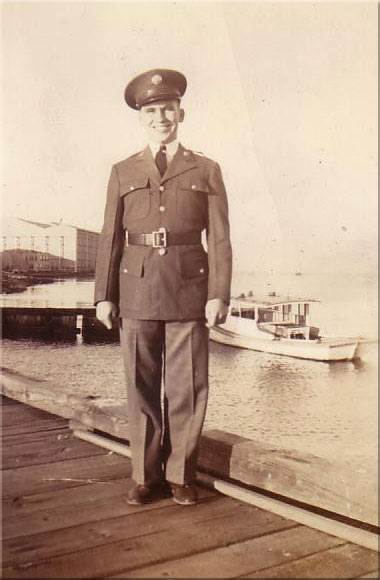 |
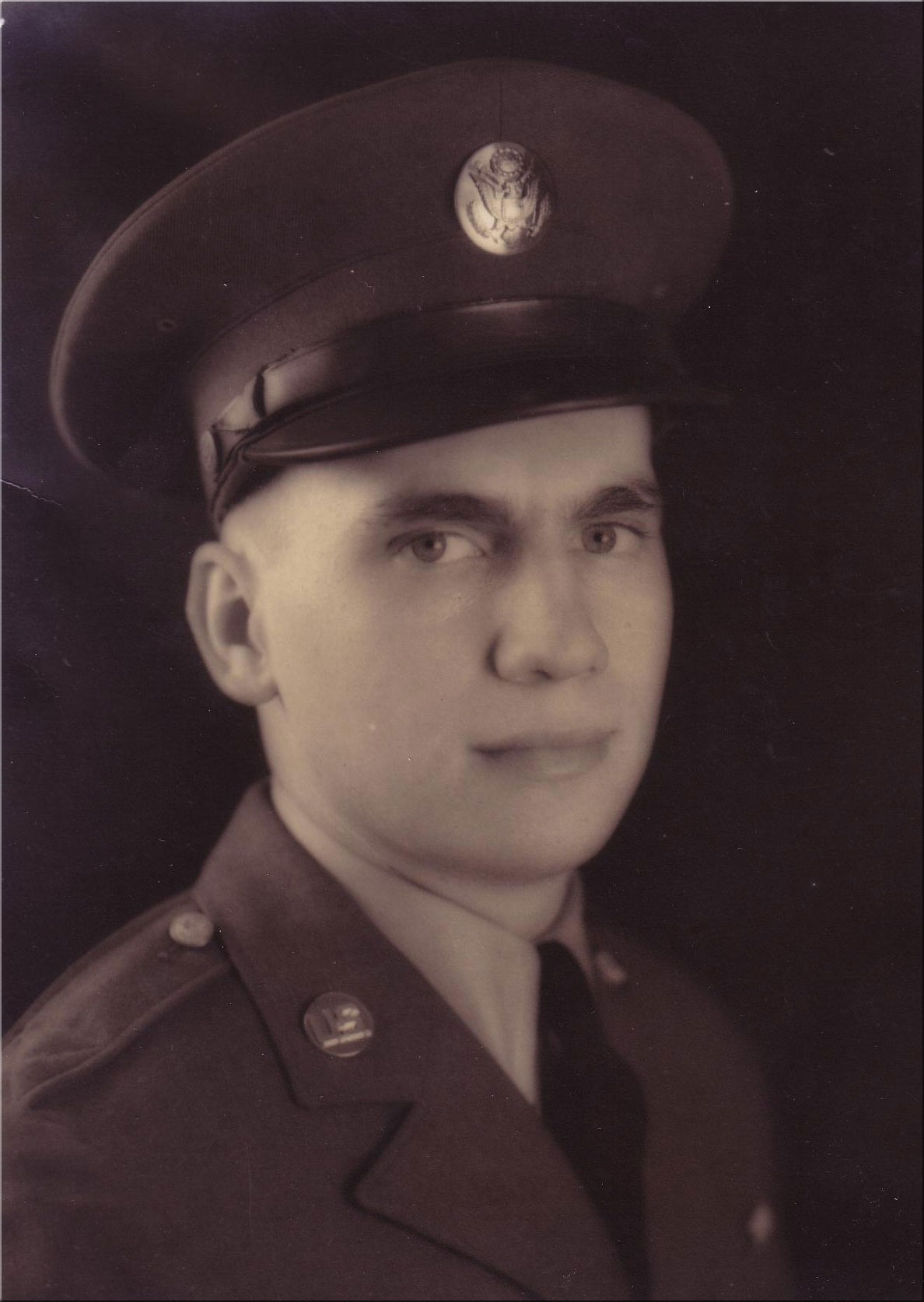 |
While at Langley, he qualified for Officers Candidate School at Fort Knox in Kentucky. From the OCS building he had a view on the terrain where the 8th Armored Band held its parades.
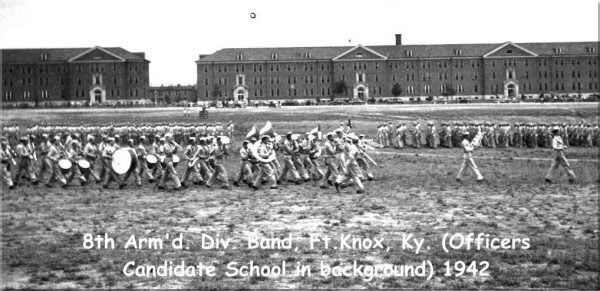 |
| Picture courtesy of 8th Armored Division Association |
After finishing the Officers Candidate School, he was commissioned as a 2nd Lieutenant and was sent to Camp Polk, Louisiana, where he served as an instructor with the 88th Cavalry Reconnaissance Squadron (Mechanized) of the 8th Armored Division untill he was sent to Europe at the end of 1944. Moments where he could visit his family in Erie County, PA were rare.
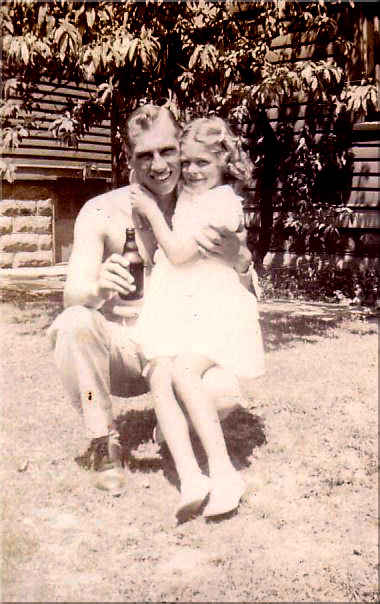 |
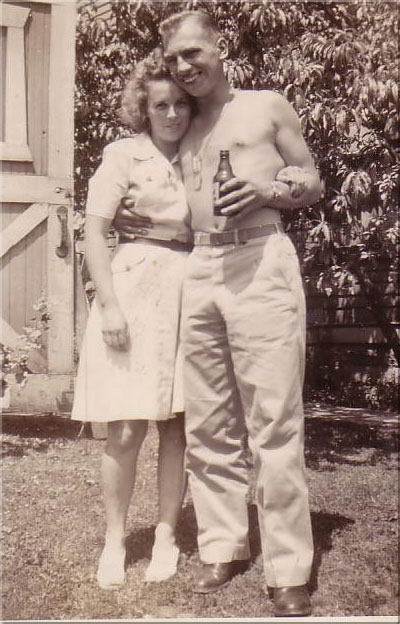 |
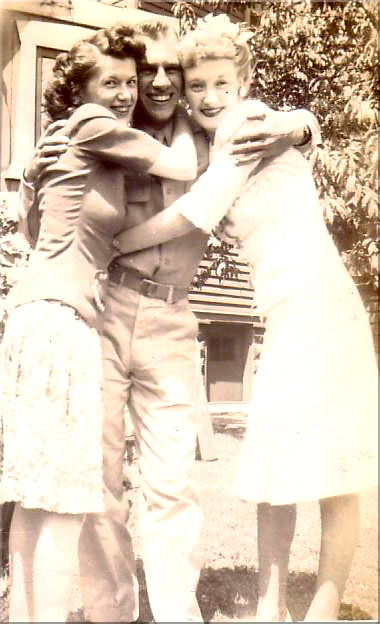 |
| Kenneth Robinson and Snookie - Kenneth and Bette - Kenneth, Helen Sutch and cousin Honey |
The 8th Armored Division was initially called the 'Iron Snake', but subsequently adopted the 'Thundering Herd' moniker and another, it's war code name of 'Tornado'. From June 1942 until January 1943 it served as a training division. It trained cadre and replacements for many other armored divisions. While stationed at Fort Knox, the Division was the official military guardian of the United States Gold Vault.
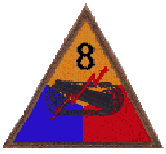 |
8th
Armored Division patch |
In February 1943 the Division
was relieved of its cadre training mission and directed to attain combat-ready
status. In March, the division moved to North Camp Polk, Louisiana.
During the month of September 1943, the 8th Armored Division successfully accomplished
complete reorganization from the old - style triangular division, armored, to
the new "light" armored division, in which a tank battalion's Company
D was equipped with the light(armored) tanks.
In September 1944 the 8th Armored Division was placed in top priority for overseas
movement.
As of 24 oktober 1944 the
division was organized in three Combat Commands : Combat Command A (CCA); Combat
Command B (CCB); Combat Command R: (CCR)
They departed for Camp Kilmer,
New Jersey in late October 1944. Departure from New York began on 7 November
with arrival in England on 18 November 1944. Ships carrying personnel of the
8th Armored were HMT Samaria, USAT George W. Goethals, the SS St. Cecelia and
the USAT Marine Devil which transported the 36th Tank Battalion men to Europe.
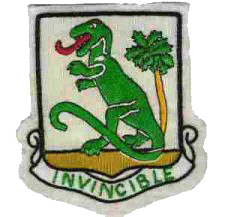 |
36th Tank Battalion patch |
Kenneth and the other men
of Company D, 36th Tank battalion, disembarked at the ruined cities of Le Havre
and Rouen at 5 January. There they had their first idea of the destruction on
the Continent. The Division was grouped into units and moved to the vicinity
of Bacqueville, located north of Rouen, France. While at St. Jure, the men took
a fancy to having all their hair cut off.
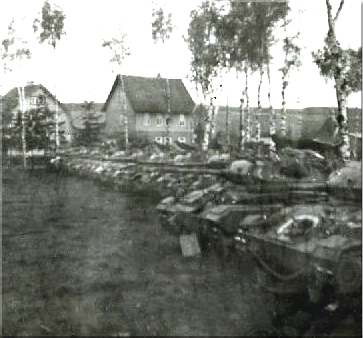 |
D Company M24 Tanks in line. (Picture courtesy of Mr. Charles Gordon) |
D-Company, as the battalion’s
light tank company, was one of the very few to be solely equipped with the M24
'Chaffee' light tank, which was introduced to the ETO in January 1945.
The first batch of 200 M24 tanks (December 1944) did go to the First and Ninth
Army. These M24s were not replacements for the M5A1 Stuart tank but arrived
with the four last armored divisions to be deployed in the ETO, the 8th, 13th,
16th and 20th Armored Divisions.
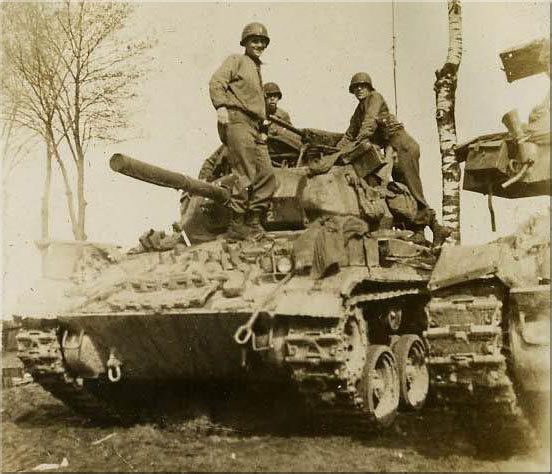 |
| Picture courtesy of Mr. Charles Gordon |
D Company painted their unit identification bumper codes and the tank registration number on the turret rather than the hull, as the hull of the M24 tended to become cluttered with the crew’s gear, obscuring the numbers. In the case of the unit codes, these were carried on the front of the gun mantlet, split top to bottom, and then repeated again on the rear of the turret stowage bin, all in white.
This picture was taken after the Rheinberg battle and shows 2nd Lt. Harold C. Gordon and crew. Lt. Gordon was the replacement officer for first Platoon as of 8 March 1945, after Lt. Kenneth R. Robinson was killed in action on 5 March 1945.
At 0800 h, 2 February 1945,
they began their 250 mile motor march to Margraten, the Netherlands. Margraten
was at that time the site of the 9th Army American Military Cemetery, which
is now known as the Netherlands American Cemetery and Memorial.
Kenneth - platoon leader of First Platoon, D-Company - and the other men pulled
in late in the afternoon of 3 February. The spring weather had changed en route
into cold wet weather and they arrived tired and hungry but within a few days
found they had a "home" with the hospitable people of Margraten.
 |
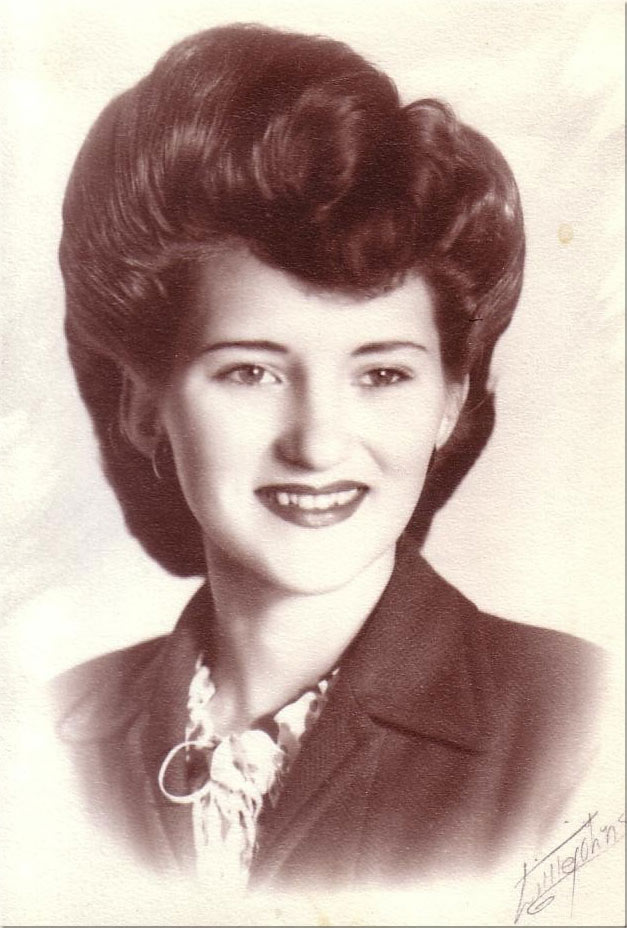
In Margraten worries about what the future might bring apparently brought him to reassuring his family that he is okay and requesting to contact Miss Ernestine McIntosh if anything should happen.
8th Armored Division Headquarters
was located at Simpelveld. CCA was quartered in the area of Gulpen; CCB was
bivouaced at Margraten, CCR was located at Cadier-en-Keer
Everyone was impressed by the remarkable cleanliness of the Dutch people and
their homes though they could never quite figure out the necessity for having
a manure pile adjacent to the home. They learned that there were really windmills,
wooden shoes and hand-scoured sidewalks, as well as sweetish beer that even
drove some of the men to drinking water. In Margraten, they also had their first
experience with buzz-bombs (V1-rockets), the terrifying jet-propelled weapons
that blazed trails across the sky to the accompaniment of a roar like that of
a squadron of airplanes.
The Ninth Army military cemetery naturally drew many remarks from the men, all
in terms of hoping never to have to pass the entrance gate.
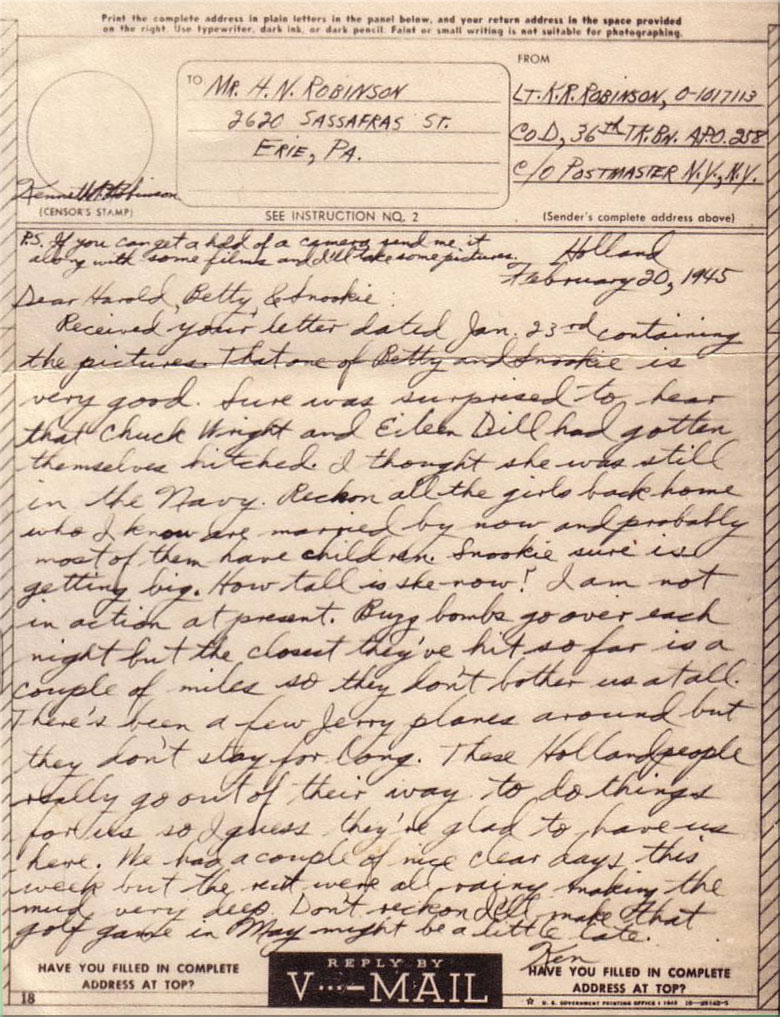 |
On 21 February they moved
out as a part of Combat Command B with A- Company of the 49th Armored Infantry
Battalion and B-Troop of the 88th Reconnaissance Squadron Mechanized, to Posterholt.
There they replaced the Durham Light Infantry of the British Seventh Armored
Division.
Posterholt proved to be a quiet, defensive sector where they practiced indirect
fire on the opposing enemy positions in Vlodrop and sent out several successful
night patrols from Troop-B of the 88th and A-Company of the 49th Infantry. In
the night of 24-25 February they took their first prisoners when the 49th brought
in seven very scared and much surprised Germans. The reconnaissance platoon
of the 36th also made a successful night patrol to study enemy strong points
northwest of Vlodrop. Aside from an occasional shelling from enemy mortars and
artillery, and even though the Germans were only several hundred yards away,
their stay in Posterholt was relatively quiet. To keep up morale and prevent
boredom, they established a recreation hall which boasted a coke and beer bar
and also showed motion pictures, within three hundred yards of the enemy line.
On the 23rd of February they took part in the famous Roer barrage which shattered the silence of the night and prepared the way for Allied troops to cross the Roer. The very earth shook and trembled for forty-five minutes without ceasing as their guns spat out steel, death and destruction.
Plans for attacking and occupying
Vlodrop on the west bank of the Roer had been completed but before the battalion
commander could obtain clearance for the attack, orders came for them to move
south to an established position and take part in an outflanking movement as
part of the attack of the Ninth Army. The battalion, with attached troops, departed
from Posterholt at 1800, 27 February 1945, moving all night and the next day
by way of Sittard, Gangelt, Geilenkirchen, Randerath, Brachelen, crossing the
Roer River at Bilfarth, then going through Gladbach, Gerdenrath and Wildenrath,
where they stopped overnight on the night of 28 February and 1 March. During
this march they came through the now useless Siegfried Line upon which Germany
bad based its hope of holding back invasion. Those fortifications and pillboxes
were just so much junk and concrete mass now and hardly noticed by the passing
troops.
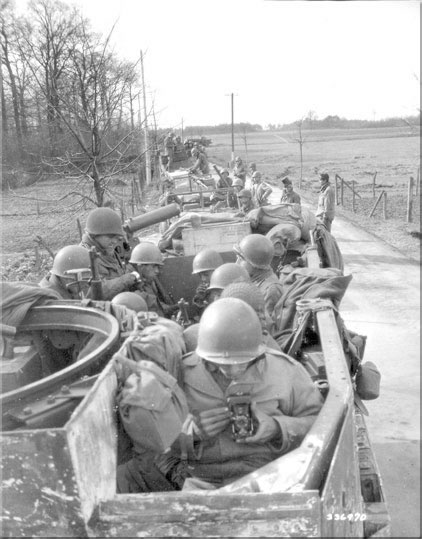 |
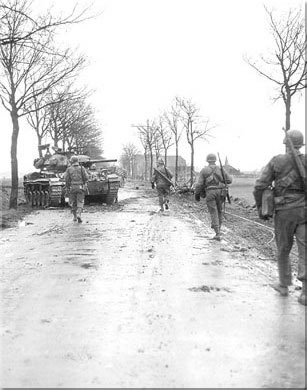 |
 |
| Pictures courtesy of 8th Armored Division Association | ||
Receiving orders to move to
an attack position in the vicinity of Wachtendonk, Germany, the battalion along
with its attachments, now officially known as Task Force Van Houten, departed
from it’s position southeast of Wlldenrath early in the morning of 2 March
and proceeded toward Wachtendonk with the mission of relieving a similar task
force of CCA of the 8th. Task Force Van Houten arrived after dark southeast
of Wankum, Germany, where forward movement was halted because of an anti-tank
ditch.
The blood-red clouds in the sky that greeted the sun on the morning of Monday
5 March 1945 were a forecast of the shedding of the blood of men of the Thirty-Sixth
who were to die that day on German soil.
The tankers were to meet an overwhelming force, yet in spite of great odds they
were to emerge victorious from the ordeal.
On the morning of the 5th, the 36th Tank Battalion, as a part of CCB, were attached to the 35th Infantry Division with the mission of moving forward, seizing Lintfort and Rheinberg and then, if ordered, to seize the bridge across the Rhine at Wesel. Their G-2 information was that there was only minor opposition to be expected; that there were only three self-propelled weapons, one anti-tank gun, no tanks and about 300 disorganized and demoralized soldiers on this side of the Rhine. That information, they were to learn soon, was "all wet."
D-Company, the light tank company of the 36th, commanded by Captain Arthur C. "Ace" Erdmann, moved over Kamperbruck to an attack position southeast of Alterspan Wood. The M24 tanks moved with no prior reconnaissance, and had no idea of what was ahead.
Enemy guns engaged the company
but were speedily knocked out. The combat commander then sent a platoon of infantry
to D-Company and ordered an attack on Rheinberg from the southwest. Receiving
fire from anti-tank guns, small arms, mortars and artillery, the company nevertheless
moved forward and after the third assault, three tanks, later knocked out, entered
Rheinberg. The attack was costly both in tanks and men. Captain Erdmann lost
a foot as the result of stepping on a mine and platoon leaders, Lt. Frank Rich
and Lt. Kenneth Robinson died heroes' deaths as they led their men forward.
During the action D-Company was credited with knocking out three 88s, one tank
and one 150mm gun.
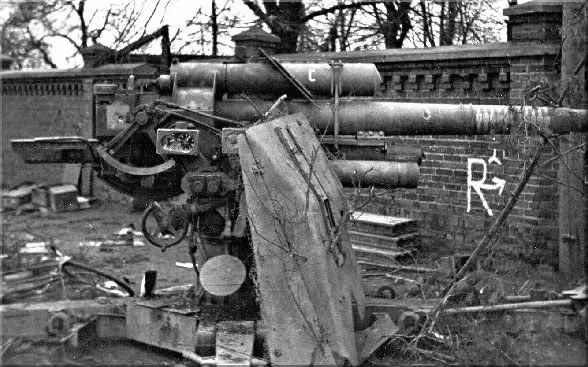 |
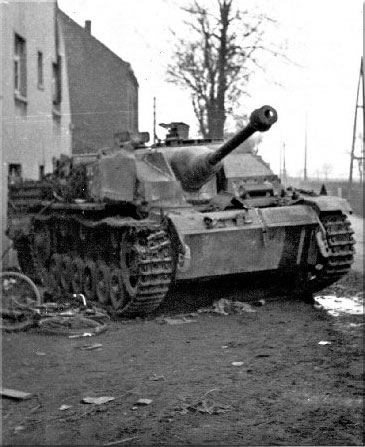 |
| Pictures courtesy of 8th Armored Division Association |